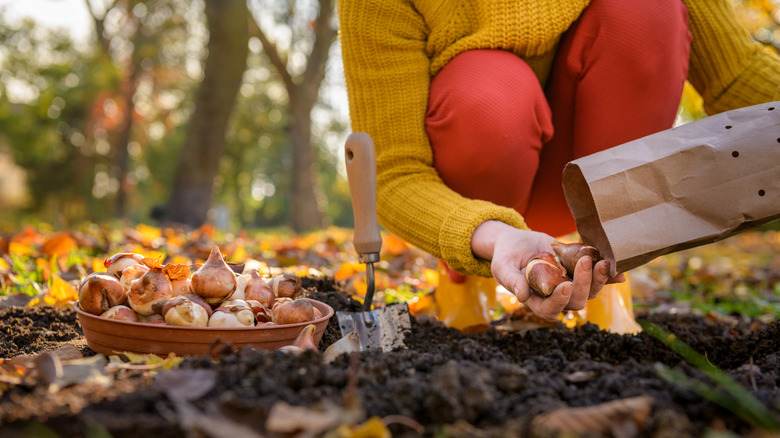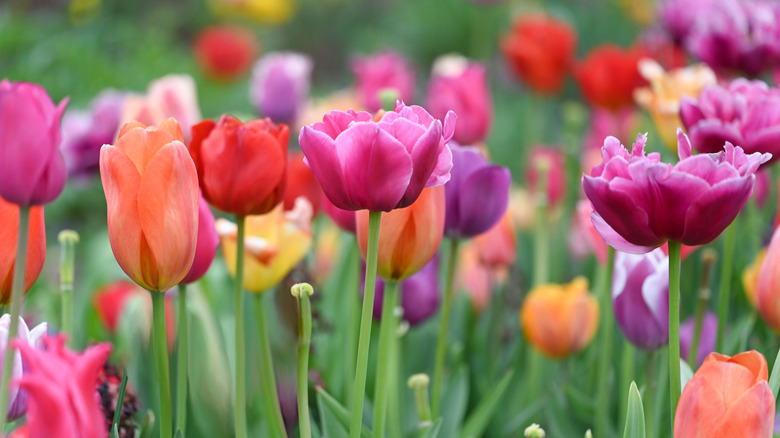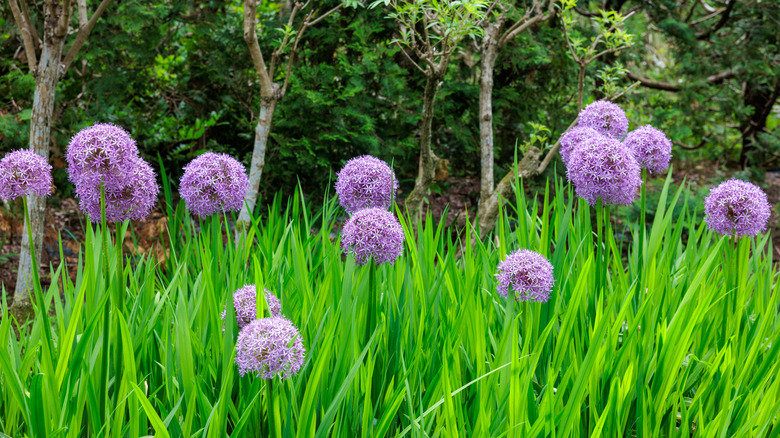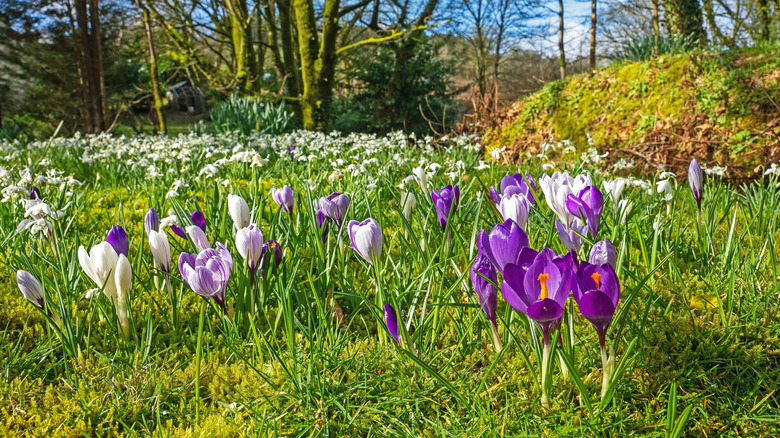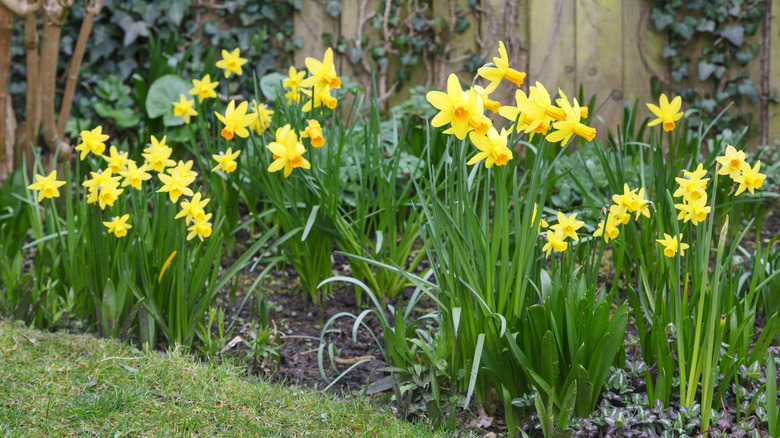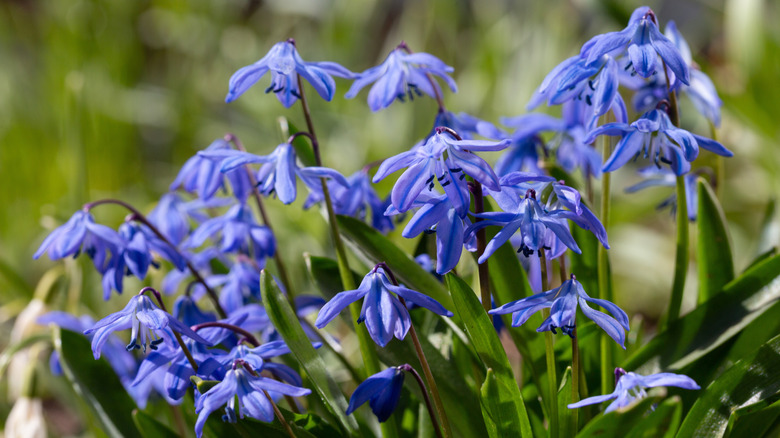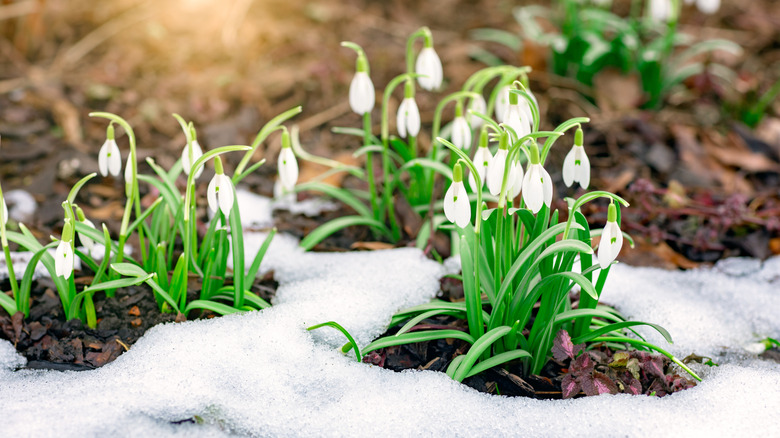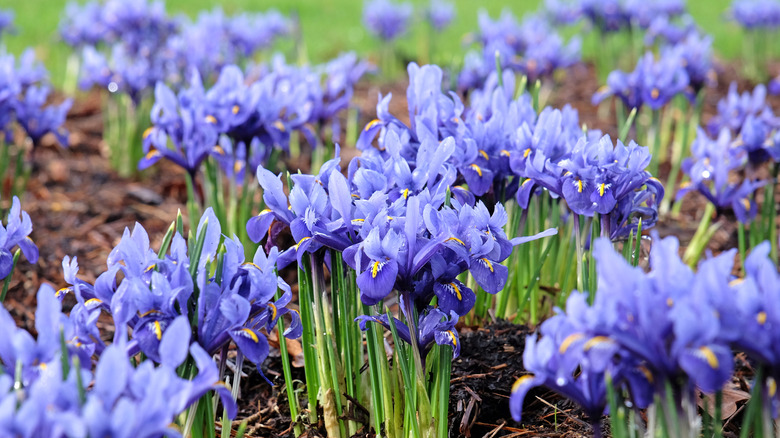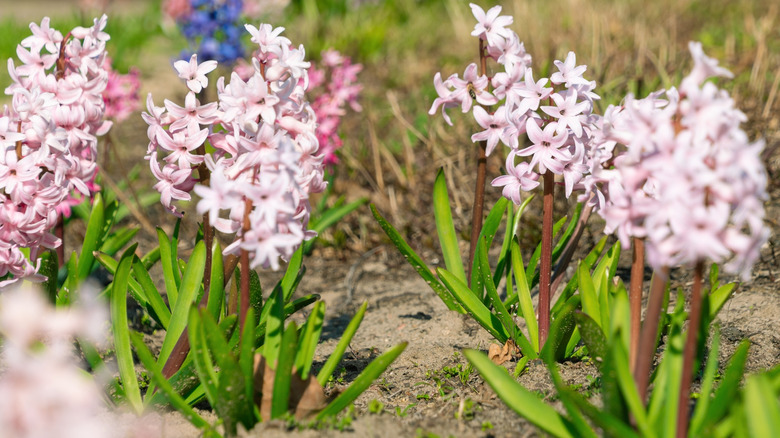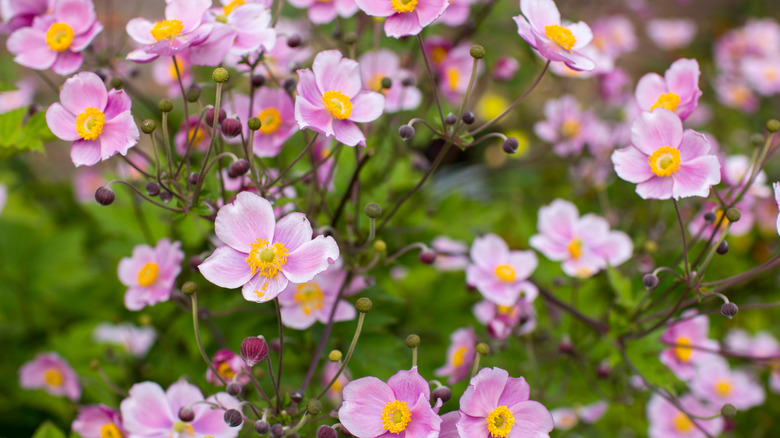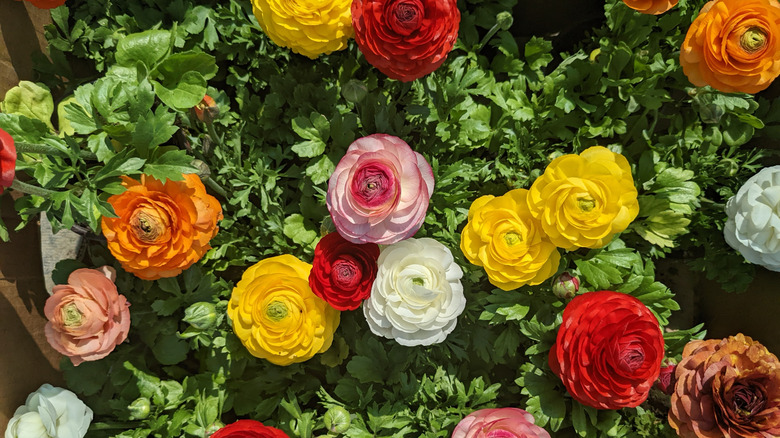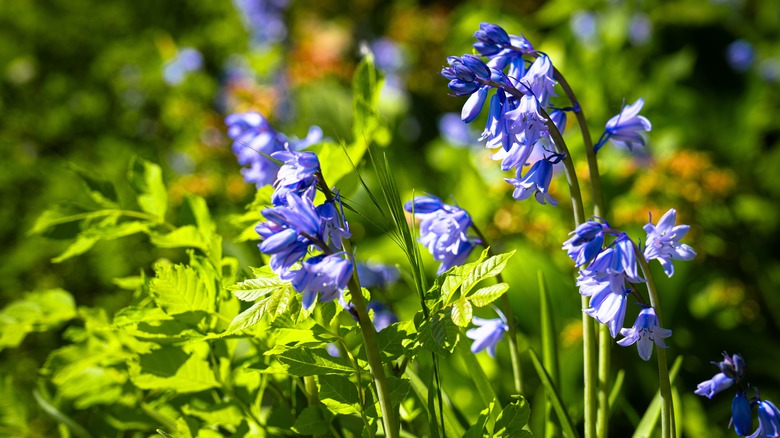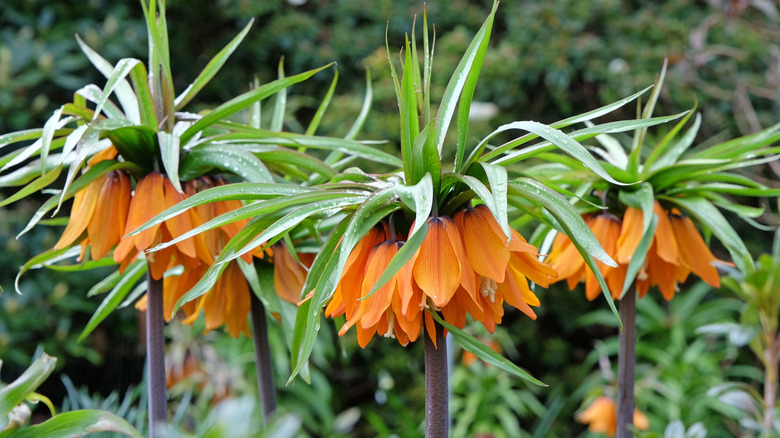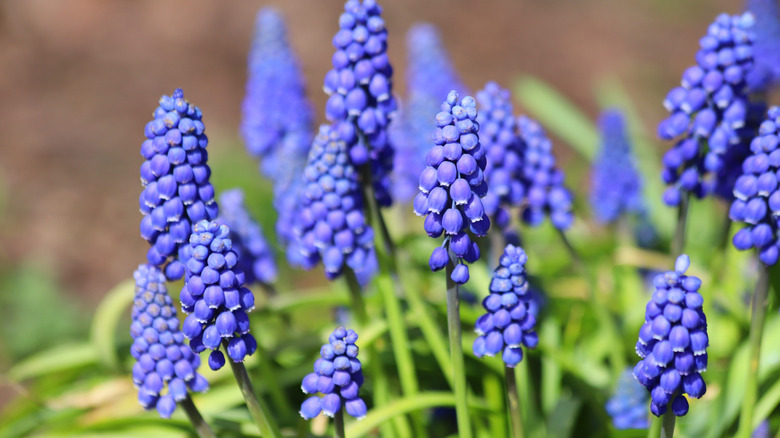13 Bulbs You Can Plant In October For Stunning Spring Blooms
October might seem like the perfect time to start winding down your garden planting, mostly spent preparing the soil for the dreaded, but inevitable first frost. You may be employing a few choice ground covers that are great for preventing soil erosion or covering garden beds with tarps to mitigate the effects of harsh winter weather. But there's one important step you should be making to ensure a vibrant spring garden — planting bulbs. Fall isn't the time to completely close up shop; it's the moment to quietly set the stage for next year's growth. Beneath the surface, your garden is still alive and thriving, ready to host the next batch of bulbs that will become your first signs of spring. Bulbs you can plant in October for stunning spring blooms include irises, hyacinths, and snowdrops.
Many flowering plants require cooler temperatures as part of their natural growing rhythm, using the period of dormancy to rest and prepare for the burst of energy required to sprout out of the soil. Planting in October gives the bulbs the time that they need to establish themselves and develop a strong system of roots before going dormant through the cold months ahead. By the time the frost fades and daylight starts to linger again, they'll be ready to push through the soil with vibrant bursts of color and life. While it may be a bit of delayed gratification, planting bulbs in October gives your flowers the time and energy necessary to come back with big blooms every spring. And with the right selection of bulbs, your patience will pay off with a spring-time garden that is teeming with new life.
Tulips
As a spring-time classic, tulips are the perfect plant to get an early start in October. Whether you love the timeless reds and yellows or the dreamy pastels of newer variants, these flowers need a jumpstart before becoming the star of your spring garden. Planting tulips in the fall provides enough time to develop an intricate root system before the plants go dormant over the winter. Come spring, these flowers will burst with vibrant colors. The bulbs should be planted about 6 inches into the soil, receiving full sun. Mix early, mid, and late-blooming varieties for a layered effect that stretches across seasons.
Allium
Think of alliums as the firework show of gardening, exploding with spherical blossoms that resemble lavender pom poms and slender stalks that stretch toward the sky. They thrive in similar conditions to tulips: A sunny, well-draining spot in your garden. Plant each bulb in October about 5 inches deep in the soil so their roots stretch out before winter. It's best to wait until the first frost to plant these bulbs, so you may need to wait a bit longer if you live in a warmer region. You should see these flowers rise up around late spring like small bursts of color.
Crocus
Crocuses are among the first flowers to signal the coming of spring, often seen emerging through small piles of snow, revealing purple blooms. Their compact size makes them the perfect addition to garden borders, or tucked between stepping stones. Planting these flowers in October ensures that their roots have time to take hold before the winter, setting the stage for an early-spring show. Place the bulbs about 3 inches deep and 3 inches apart in well-draining soil. If your goal is a colorful spring garden, don't overlook these flowers, as they can set the tone for the rest of the flowering season.
Daffodils
When it comes to classic spring flowers, daffodils no doubt come to mind. Their trumpet-shaped flowers and golden petals radiate a much-needed warmth to kick off the season of renewal. These hardy bulbs are reliable, deer-resistant, and easy to grow in both garden beds and containers. Plant each bulb about 6 inches deep into the ground, grouping them together for a more natural landscaping aesthetic. These flowers will bloom in early to mid-spring, bringing their signature "cup" shape with them. Daffodils come in shades of yellow, white, and orange that serve as a bit of vibrant warmth to kick off the seasons.
Scilla
Known as Siberian squill, scilla is a burst of blue that sweeps across garden floors just as winter starts to fade. Its delicate flowers thrive both in partial shade or full sun, making them a versatile addition to woodland gardens or open flower beds. Each bulb should be planted around 3 inches deep in October to give them time to form sturdy roots before freezing temperatures arrive. Once the plants are established, they naturalize quickly to bring a signature purple hue each spring. Their rich, blue tone pairs naturally with other early bloomers like early daffodils or snowdrops.
Snowdrops
Snowdrop is the type of flower that actually lives up to its name, often blooming when there is still snow on the ground. Their dainty, white, bell-shaped flowers bring a soft yet understated beauty to those early spring days. Plant the bulbs about 3 inches deep in partial shade and moist, well-draining soil. By planting in October, you ensure that your bulbs start their quick development early in the season, ready to emerge while the world is still covered in snow. They're a small flower, but surprisingly resilient, thriving in clusters that multiply year after year, proving that even delicate blooms can endure.
Irises
Spring blooming variants, like Dutch and Iris reticulata, are the perfect flowers to bring subtle sophistication to your garden. Their tall stems and ruffled petals range from deep violet to sky blue — small bursts of color in any spring garden. For a more natural look, iris bulbs can be planted about 12 inches apart, but they can also be planted closer together if you want a full-looking appearance. If they are planted together, these flowers will need to be divided much sooner than if they are provided room to spread out. By spring, they will emerge as refined additions to your beds.
Hyacinths
The smell of fresh hyacinth flowers is like the personification of spring, known for their lush, tightly packed blooms and sweet scent. Their rich colors — ranging from pastel pinks and purples to vivid blues — make them perfect for planting in borders or containers. Plant bulbs about 6 inches deep in the ground in an area with full sun, ensuring there is good drainage. Fall planting ensures that they form strong roots for full, healthy blooms come spring. When they finally emerge, hyacinths embody the emergence of spring with their fresh scent and delicate color palette, reminding you why you planted them in the first place.
Anemone
Every spring garden needs a delicate wildflower, and anemone fits the mold. They bloom with shades that are reminiscent of watercolors in indigo, fuchsia, and white. Each petal surrounds a dark or yellow center that offers contrast to the rest of the flower. Plant them in October to provide cool soil and good drainage so they settle in before winter in USDA Zones 8 to 10. When spring finally arrives, they'll lift towards the sun to show off their stunning colors. Anemone typically only needs about half a day worth of sun, making them perfect for those harder-to-plant spots in your garden.
Ranunculus
Ranunculus are the wild overachievers in the garden, delicate in appearance but wildly abundant once they start to bloom. Their vibrant, layered petals almost look fake when scattered around the garden. There are a number of ranunculus varieties that you should be planting in October, giving them a necessary head-start before the cold sets in. Choose plump, healthy bulbs and plant them in well-draining soil about two inches deep. Come late spring, you'll have bouquets worth of ruffled flowers that last longer than you might think, each one proving that texture can be just as important as tone.
Bluebells
If your garden has a shady nook or a path that feels a little too quiet, bluebells might be the flower you've been looking for. These woodland natives don't mind receiving a little less sun; in fact, they thrive in it. Plant them now in loose, moist soil where tree canopies will soon start to leaf out overhead. By late spring, they should transform your undergrowth into a dreamy carpet of blue, making those relatively quiet spaces feel even more magical. And their little bell-shaped flowers bring the right amount of whimsy that is perfect for spring-time blossoms.
Fritillaria
Fritillarias are unforgettable, with a unique shape and color that draws the eye. From the checkers petals of the Fritillaria meleagris to the orange crown of Fritillaria imperialis, they bring interest to any garden. Each bulb should be planted about 6 inches deep in sunny, well-draining soil. Smaller bulbs only need about 3-4 inches between one another, while larger bulbs can require 8-12 inches. These plants will also go dormant during the winter, so October is the perfect time to give them a jumpstart. By late spring, they will emerge like small structures between your other flowers, adding an exotic hint to your garden.
Muscari (Grape Hyacinths)
Though small, muscari bring some of the most charming spring flowers. Their clusters of bead-shaped blossoms mimic grapes, spilling across the ground in blue and violet. Their bulbs only need a shallow planting — just a few inches — to get started and let the plants spread naturally. The plants typically wander a bit around your garden. Muscari is the perfect flower to rise up naturally underneath tulips or daffodils, helping to shape the edge of your beds or gardens with their stunning shape. While they are considered a compact plant, their unique look ensures they don't get lost among other classic spring flowers.
